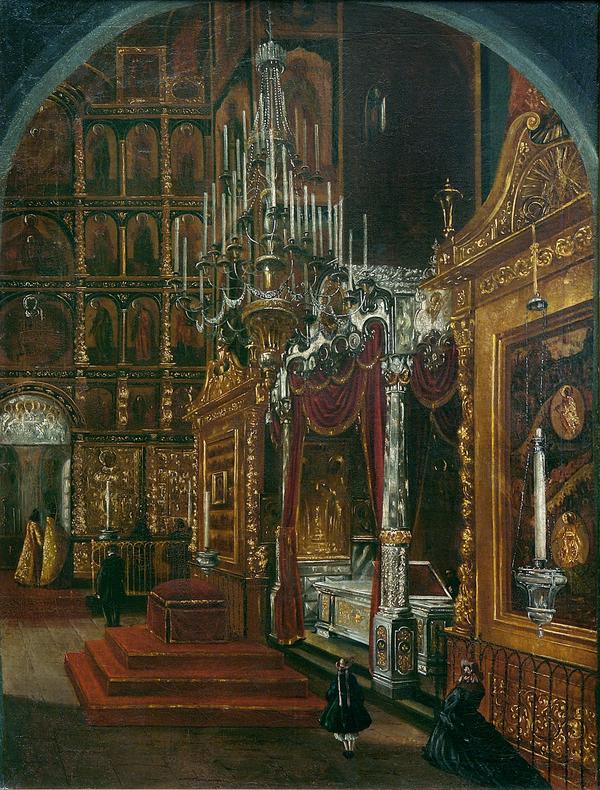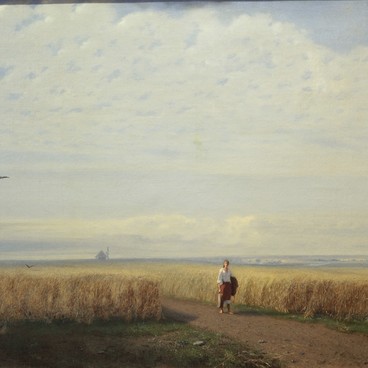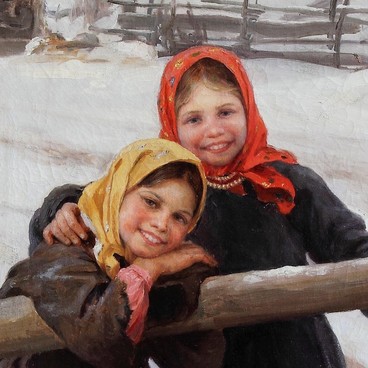Stepan Shukhvostov painted ‘View of the Dormition Cathedral in Yaroslavl’ in the 1850’s. He realistically portrayed the interior decoration of the Dormition Cathedral on Yaroslavl Spit. The painter accurately conveys the details of the interior: carving on the iconostasis and guilt decorations of the altar stone. The internal architecture looked especially majestic in contrast with small figures of people. The author emphasized the solemnity of the cathedral’s interior by combining shades of gold and red.
Stepan Shukhvostov did not study in the Imperial Academy of Arts but became its academician in 1855. After studying in the Moscow School of Arts, Sculpture and Architecture the painter showed his works to the Council of the Imperial Academy that awarded him the title of ‘unclassed artist’. Later he was granted the title of ‘nominated for an academician’ for paintings of interiors of the Holy Trinity — St. Sergius Laura and Gethsemane Skete. Finally, the Council instructed the artist to paint ‘an (ancient) cathedral interior of his choice’. On September 30, 1855 Shukhvostov presented to the Academy the ‘Interior View of the Archangel Cathedral in Moscow’. This painting brought him the title of an academician of perspective and landscape painting. The artist also returned to the subject of church interiors later. His paintings presented earlier interior decorations of some cathedrals. For instance, the artist painted the Annunciation Cathedral in the Kremlin before the restoration by Fedor Richter.
Interior painting as a separate genre originated in Russia at the turn of XVIII–XIX centuries and gradually gained wide popularity. Artist painted interiors of churches, mansions, studies of famous people. Following the restoration of a cathedral in the Novgorod Region, Nikolai Roerich wrote, addressing artists: ‘Hurry, comrades, to paint, portray, describe the beauty of our old times. Their end is getting closer. Capture the wonderful wreckage of the past for future edifices of life “. But the painters did not only portray the general view of the interior — interiors in their works talked about people who lived in them, their lifestyles and world views.
Stepan Shukhvostov did not study in the Imperial Academy of Arts but became its academician in 1855. After studying in the Moscow School of Arts, Sculpture and Architecture the painter showed his works to the Council of the Imperial Academy that awarded him the title of ‘unclassed artist’. Later he was granted the title of ‘nominated for an academician’ for paintings of interiors of the Holy Trinity — St. Sergius Laura and Gethsemane Skete. Finally, the Council instructed the artist to paint ‘an (ancient) cathedral interior of his choice’. On September 30, 1855 Shukhvostov presented to the Academy the ‘Interior View of the Archangel Cathedral in Moscow’. This painting brought him the title of an academician of perspective and landscape painting. The artist also returned to the subject of church interiors later. His paintings presented earlier interior decorations of some cathedrals. For instance, the artist painted the Annunciation Cathedral in the Kremlin before the restoration by Fedor Richter.
Interior painting as a separate genre originated in Russia at the turn of XVIII–XIX centuries and gradually gained wide popularity. Artist painted interiors of churches, mansions, studies of famous people. Following the restoration of a cathedral in the Novgorod Region, Nikolai Roerich wrote, addressing artists: ‘Hurry, comrades, to paint, portray, describe the beauty of our old times. Their end is getting closer. Capture the wonderful wreckage of the past for future edifices of life “. But the painters did not only portray the general view of the interior — interiors in their works talked about people who lived in them, their lifestyles and world views.




